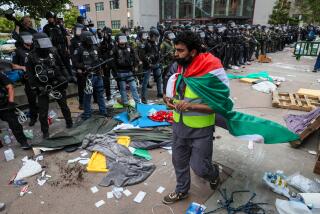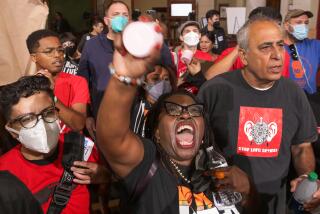Washington Mayor Imposes Curfew : Riots: After two nights of violence in the nation’s capital, officials are examining relations between the Latino community and police.
- Share via
WASHINGTON — As police enforced a dusk-to-dawn curfew Tuesday to prevent a third night of rioting in the nation’s capital, Mayor Sharon Pratt Dixon acknowledged the need to address escalating tensions between the city’s growing Latino community and its predominantly black police force.
Dixon, the first black female mayor of a major city, imposed the 7 p.m. to 7 a.m. curfew and announced plans to form a multicultural task force to assess problems within the Mt. Pleasant area two miles north of the White House.
Although several hundred protesters took to the streets just before the curfew began, pelting police with rocks and bottles, most dispersed shortly after the deadline. There were several arrests, and the streets were relatively quiet when darkness fell.
On the two previous nights, the nation watched television images eerily reminiscent of past racial disturbances, such as the Watts riot in Los Angeles 26 years ago: automobiles overturned and burning, shop windows smashed, systematic looting and clouds of tear gas.
Witnesses said the rioting started late Sunday after police arrested four men who were carousing in a small park. One of them, Daniel Enrique Gomez, 30, was shot in the chest by rookie officer Angela Jewell after he lunged at her with a knife, according to police.
Some witnesses claimed Gomez was handcuffed at the time he was shot, and this inflammatory account spread quickly through the area. Police, however, said onlookers had confused Gomez with two other men already in handcuffs. Gomez remains hospitalized in critical condition.
In the District of Columbia, as in other areas where race riots have occurred, problems of unemployment, crowded housing and poor police relations had festered for a long time, according to residents.
There is, however, one obvious difference from previous riots: Washington’s violence has been centered in a neighborhood that is heavily Latino, while the district’s municipal government and police force are dominated by blacks.
Mt. Pleasant is an area of aging apartment buildings, row houses and small businesses inhabited largely by Latinos, the fastest-growing minority group in Washington. The residents include many illegal aliens from El Salvador and Honduras. The recession has cost most of them their first jobs here as restaurant workers, housemaids and laborers. Idle much of the day, with some of the men drinking on the sidewalks and in the public parks, they often are hassled by police, residents say.
No matter what actually happened to Gomez, community leaders said the Sunday night incident caused an outpouring of anger and frustration that had been simmering for months.
“Nobody wants violence, but we feel somebody got shot who’s one of our own,” said Quique Aviles, a resident who joined the crowds in the street. “The problems with the police here are not new. We’ve been harassed for a long time.”
Some Latinos said they were accustomed to drinking outdoors in their native Central American countries and that many have continued the practice here in an area of crowded apartments.
“If we had big houses and air conditioning, we wouldn’t have to stand in the streets,” Mario Vasquez, a construction worker from Honduras, told the Washington Post.
Police counter that public drinking, which is against the law in the District of Columbia, leads to street fights, domestic disputes and littering of the streets with beer bottles.
“We enforce all the laws that impact on the quality of life in the district,” said Lt. Reginald Smith, a police spokesman.
But communication between the police and Latino residents appears to be poor. Some claim the police do not listen to their complaints because they cannot understand Spanish. Smith said only about 140 of the department’s 4,900 officers are Latino, and few of the remainder understand Spanish.
Rob Paral of the National Assn. of Latino Elected Officials said poor police relations reflect the fact that in contrast to Los Angeles or San Antonio, “Latinos in Washington are an unknown quantity. There is no history here about what our special needs are.”
Washington has no Latino member on the City Council or on the school board, he noted. Yet Washington’s Latino community has grown by 85% in the past decade, one of the fastest rates in the nation.
To help forestall further disturbances, Raul Yzaguirre, president of the National Council of La Raza, said Latino community leaders will remain in the area to ask people to be peaceful.
Dixon, who has been mayor only four months, said Latino frustrations could not excuse the millions of dollars in property damage or the 55 arrests caused by two nights of rioting.
More to Read
Sign up for Essential California
The most important California stories and recommendations in your inbox every morning.
You may occasionally receive promotional content from the Los Angeles Times.













